Cross-Cultural Analysis: Traditional Marketing Techniques Report
VerifiedAdded on 2023/01/18
|9
|2110
|76
Report
AI Summary
This report delves into the realm of cross-cultural marketing, examining the relevance of traditional techniques in the 21st century. It begins by introducing the concept of cross-cultural analysis and its significance in understanding consumer behavior across diverse cultural landscapes. The core of the report lies in a detailed analysis of three key techniques: Hofstede's cultural dimensions, Hall and Hall's high-context/low-context framework, and Trompenaars' dimensions of cultural differences. Each technique is critically evaluated, highlighting its key perspectives, dimensions, and suitability for different marketing scenarios. The report then provides a comparative analysis of these techniques, contrasting their strengths, weaknesses, and key perspectives. Ultimately, the report concludes that Hofstede's cultural dimensions technique remains highly relevant in the contemporary world, offering a comprehensive framework for understanding cultural nuances. The report uses the example of comparing the United Kingdom and China to illustrate the application of Hofstede's model. The report is written for a Marketing across Cultures Project and covers the relevance of traditional techniques such as Hofstede, Wills et al, Hall and Hall, Trompenaars in the 21st Century.

Marketing across Cultures
Project CW1
“Cross-Cultural Analysis – are traditional techniques such as Hofstede, Wills et al, Hall and
Hall, Trompenaars still relevant in the 21st Century?”
1
Project CW1
“Cross-Cultural Analysis – are traditional techniques such as Hofstede, Wills et al, Hall and
Hall, Trompenaars still relevant in the 21st Century?”
1
Paraphrase This Document
Need a fresh take? Get an instant paraphrase of this document with our AI Paraphraser
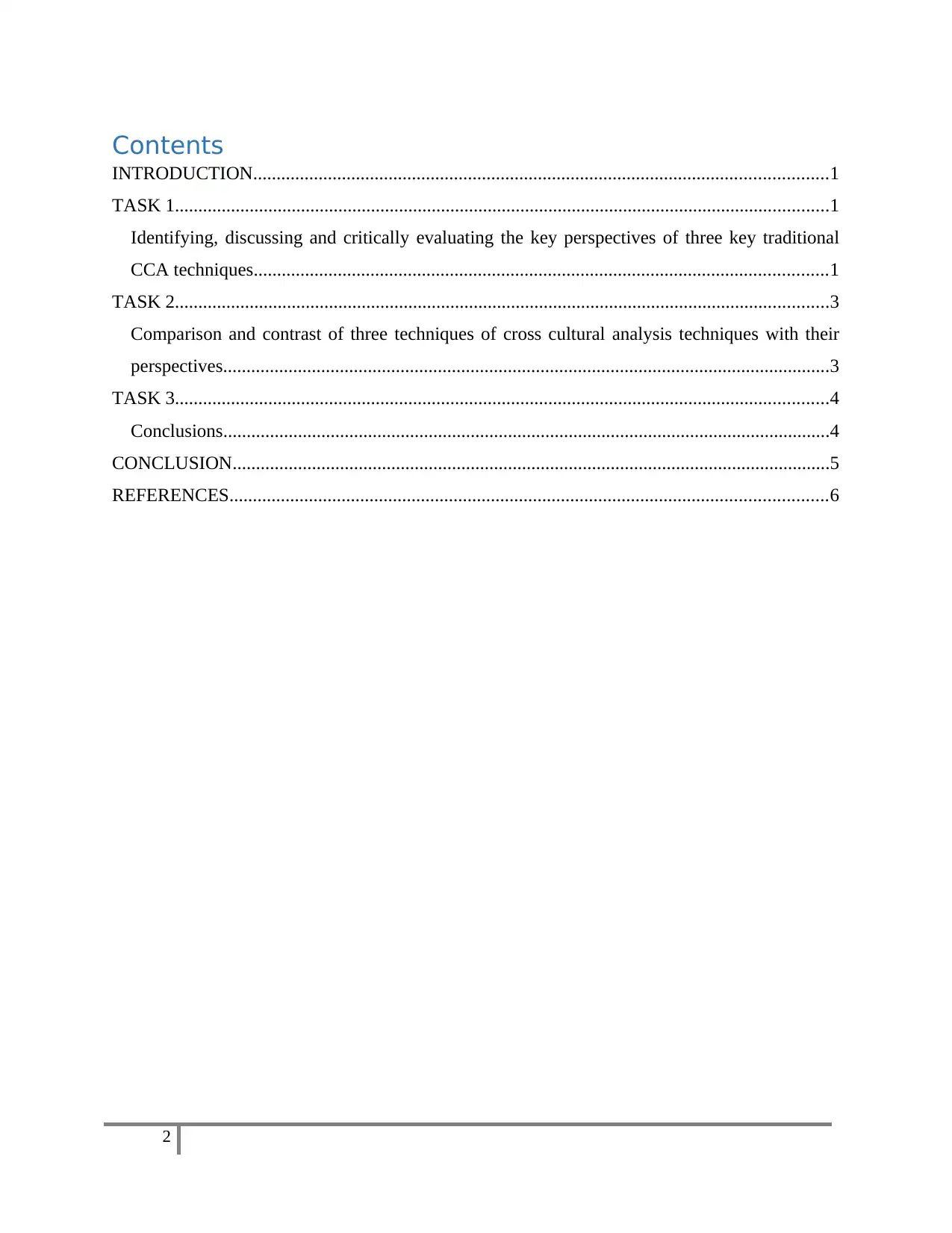
Contents
INTRODUCTION...........................................................................................................................1
TASK 1............................................................................................................................................1
Identifying, discussing and critically evaluating the key perspectives of three key traditional
CCA techniques...........................................................................................................................1
TASK 2............................................................................................................................................3
Comparison and contrast of three techniques of cross cultural analysis techniques with their
perspectives..................................................................................................................................3
TASK 3............................................................................................................................................4
Conclusions..................................................................................................................................4
CONCLUSION................................................................................................................................5
REFERENCES................................................................................................................................6
2
INTRODUCTION...........................................................................................................................1
TASK 1............................................................................................................................................1
Identifying, discussing and critically evaluating the key perspectives of three key traditional
CCA techniques...........................................................................................................................1
TASK 2............................................................................................................................................3
Comparison and contrast of three techniques of cross cultural analysis techniques with their
perspectives..................................................................................................................................3
TASK 3............................................................................................................................................4
Conclusions..................................................................................................................................4
CONCLUSION................................................................................................................................5
REFERENCES................................................................................................................................6
2

3
⊘ This is a preview!⊘
Do you want full access?
Subscribe today to unlock all pages.

Trusted by 1+ million students worldwide

INTRODUCTION
Marketing across cultures is the phenomenon in which consumer’s perception of product is
ascertained by analysing consumer’s complexity, familiarity and compatibility. This concept
requires special sensitivity to the diversity of consumer needs (Ng, 2013). The main aim of this
report is to develop an understanding about cross cultural analysis and its approaches which are
valid in 21st century as well. In this report key perspectives of three key traditional CCA
techniques are analysed along with comparison among them. One out of these techniques will be
selected which can be applied in 21st century’s contemporary world which is then analysed in
accordance to its relevance in different countries.
TASK 1
Identifying, discussing and critically evaluating the key perspectives of three key traditional
CCA techniques
Cross cultural analysis is an evaluation in which social research across ethnic groups within
a society is conducted. This analysis is a traditional method as it has a long-gone history in which
these types of researches were conducted for the purpose of addressing issue of culture diversity.
There are various traditional approaches of conducting cross cultural analysis and some of them
are even relevant in 21st century. Three of these techniques are Hofstede, Hall and Hall,
Trompenaars which are discussed below:
Hofstede cross cultural analysis technique:
According to Douglas and Samuel Craig (2011), Hofstede is the most effective technique to
analyse cross cultures as it involves all the elements by which culture of two or more nations can
be determined. This technique takes 6 dimensions into account by which diversity in cultures is
ascertained. These dimensions are Power Distance Index, by which power distribution into
varied nations is analysed. High PDI refers to acceptance of power within few hands and low
PDI refers region where equalization of power is stressed. Another dimension considered by
Hofstede is Individualism and collectivism which identifies whether a nation prefer loosely or
tightly knitted social framework. Similar to this, third dimension is masculinity and femininity
(MAS) in which preference of society is judged against their heroism and modesty. Other
dimensions which are uncertainty avoidance index (UAI), long- and short-term orientation
(LTO) and indulgence versus restraint (IND) refers preference of nations against their approach
1
Marketing across cultures is the phenomenon in which consumer’s perception of product is
ascertained by analysing consumer’s complexity, familiarity and compatibility. This concept
requires special sensitivity to the diversity of consumer needs (Ng, 2013). The main aim of this
report is to develop an understanding about cross cultural analysis and its approaches which are
valid in 21st century as well. In this report key perspectives of three key traditional CCA
techniques are analysed along with comparison among them. One out of these techniques will be
selected which can be applied in 21st century’s contemporary world which is then analysed in
accordance to its relevance in different countries.
TASK 1
Identifying, discussing and critically evaluating the key perspectives of three key traditional
CCA techniques
Cross cultural analysis is an evaluation in which social research across ethnic groups within
a society is conducted. This analysis is a traditional method as it has a long-gone history in which
these types of researches were conducted for the purpose of addressing issue of culture diversity.
There are various traditional approaches of conducting cross cultural analysis and some of them
are even relevant in 21st century. Three of these techniques are Hofstede, Hall and Hall,
Trompenaars which are discussed below:
Hofstede cross cultural analysis technique:
According to Douglas and Samuel Craig (2011), Hofstede is the most effective technique to
analyse cross cultures as it involves all the elements by which culture of two or more nations can
be determined. This technique takes 6 dimensions into account by which diversity in cultures is
ascertained. These dimensions are Power Distance Index, by which power distribution into
varied nations is analysed. High PDI refers to acceptance of power within few hands and low
PDI refers region where equalization of power is stressed. Another dimension considered by
Hofstede is Individualism and collectivism which identifies whether a nation prefer loosely or
tightly knitted social framework. Similar to this, third dimension is masculinity and femininity
(MAS) in which preference of society is judged against their heroism and modesty. Other
dimensions which are uncertainty avoidance index (UAI), long- and short-term orientation
(LTO) and indulgence versus restraint (IND) refers preference of nations against their approach
1
Paraphrase This Document
Need a fresh take? Get an instant paraphrase of this document with our AI Paraphraser
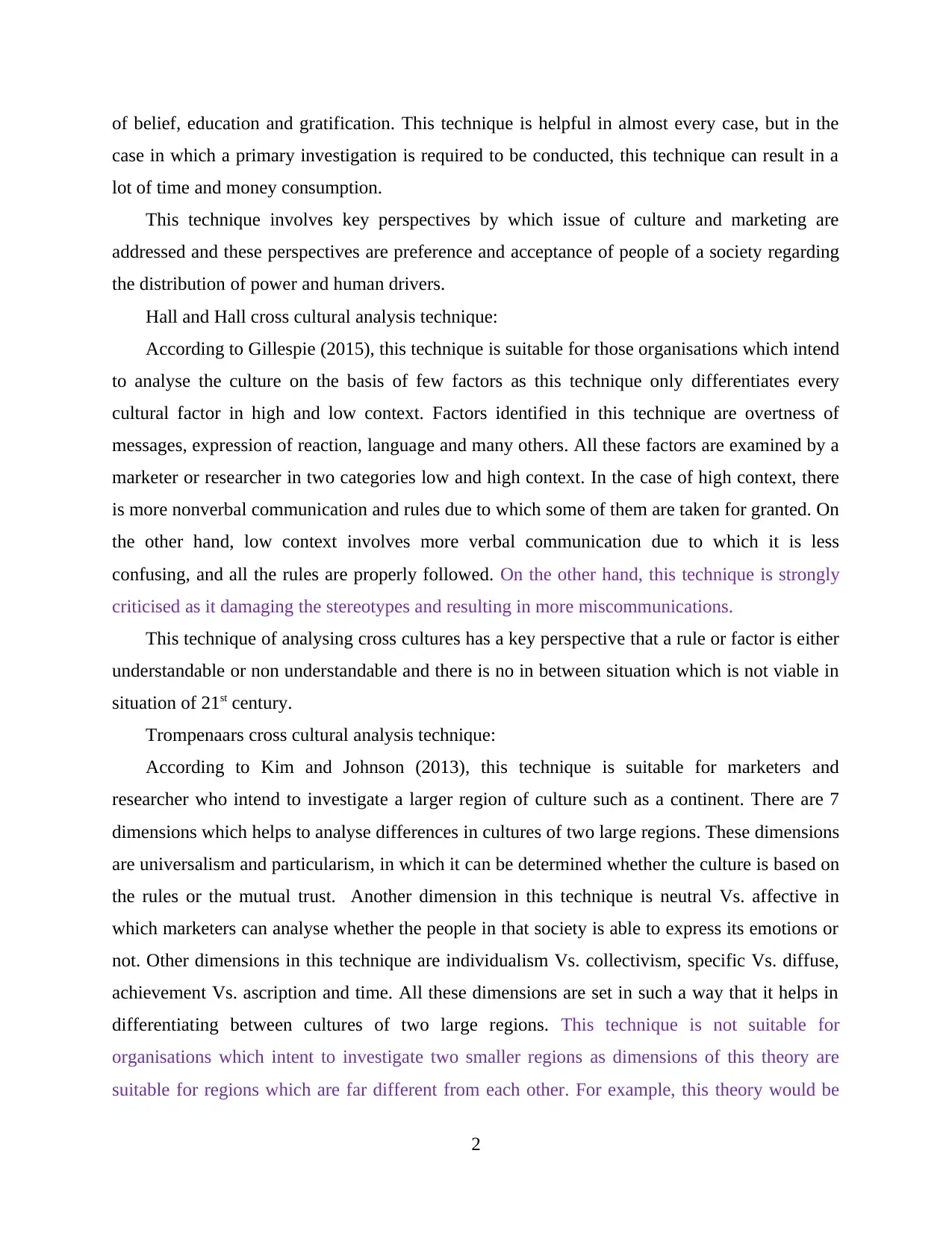
of belief, education and gratification. This technique is helpful in almost every case, but in the
case in which a primary investigation is required to be conducted, this technique can result in a
lot of time and money consumption.
This technique involves key perspectives by which issue of culture and marketing are
addressed and these perspectives are preference and acceptance of people of a society regarding
the distribution of power and human drivers.
Hall and Hall cross cultural analysis technique:
According to Gillespie (2015), this technique is suitable for those organisations which intend
to analyse the culture on the basis of few factors as this technique only differentiates every
cultural factor in high and low context. Factors identified in this technique are overtness of
messages, expression of reaction, language and many others. All these factors are examined by a
marketer or researcher in two categories low and high context. In the case of high context, there
is more nonverbal communication and rules due to which some of them are taken for granted. On
the other hand, low context involves more verbal communication due to which it is less
confusing, and all the rules are properly followed. On the other hand, this technique is strongly
criticised as it damaging the stereotypes and resulting in more miscommunications.
This technique of analysing cross cultures has a key perspective that a rule or factor is either
understandable or non understandable and there is no in between situation which is not viable in
situation of 21st century.
Trompenaars cross cultural analysis technique:
According to Kim and Johnson (2013), this technique is suitable for marketers and
researcher who intend to investigate a larger region of culture such as a continent. There are 7
dimensions which helps to analyse differences in cultures of two large regions. These dimensions
are universalism and particularism, in which it can be determined whether the culture is based on
the rules or the mutual trust. Another dimension in this technique is neutral Vs. affective in
which marketers can analyse whether the people in that society is able to express its emotions or
not. Other dimensions in this technique are individualism Vs. collectivism, specific Vs. diffuse,
achievement Vs. ascription and time. All these dimensions are set in such a way that it helps in
differentiating between cultures of two large regions. This technique is not suitable for
organisations which intent to investigate two smaller regions as dimensions of this theory are
suitable for regions which are far different from each other. For example, this theory would be
2
case in which a primary investigation is required to be conducted, this technique can result in a
lot of time and money consumption.
This technique involves key perspectives by which issue of culture and marketing are
addressed and these perspectives are preference and acceptance of people of a society regarding
the distribution of power and human drivers.
Hall and Hall cross cultural analysis technique:
According to Gillespie (2015), this technique is suitable for those organisations which intend
to analyse the culture on the basis of few factors as this technique only differentiates every
cultural factor in high and low context. Factors identified in this technique are overtness of
messages, expression of reaction, language and many others. All these factors are examined by a
marketer or researcher in two categories low and high context. In the case of high context, there
is more nonverbal communication and rules due to which some of them are taken for granted. On
the other hand, low context involves more verbal communication due to which it is less
confusing, and all the rules are properly followed. On the other hand, this technique is strongly
criticised as it damaging the stereotypes and resulting in more miscommunications.
This technique of analysing cross cultures has a key perspective that a rule or factor is either
understandable or non understandable and there is no in between situation which is not viable in
situation of 21st century.
Trompenaars cross cultural analysis technique:
According to Kim and Johnson (2013), this technique is suitable for marketers and
researcher who intend to investigate a larger region of culture such as a continent. There are 7
dimensions which helps to analyse differences in cultures of two large regions. These dimensions
are universalism and particularism, in which it can be determined whether the culture is based on
the rules or the mutual trust. Another dimension in this technique is neutral Vs. affective in
which marketers can analyse whether the people in that society is able to express its emotions or
not. Other dimensions in this technique are individualism Vs. collectivism, specific Vs. diffuse,
achievement Vs. ascription and time. All these dimensions are set in such a way that it helps in
differentiating between cultures of two large regions. This technique is not suitable for
organisations which intent to investigate two smaller regions as dimensions of this theory are
suitable for regions which are far different from each other. For example, this theory would be
2

appropriate if an organisation need to investigate United Kingdom and Australia. But it would be
not appropriate if an investigation of England and Wales is required to be conducted.
This technique has key perspective by which issue of cultural and marketing is approached.
This perspective is that difference in culture can be only measured by above dimensions and also
that culture starts to differentiate between larger demographic regions.
All the above three techniques can help marketers of organisations to assess cultural
differences between nations or regions and has varied perspectives by which marketers
approaches the issue of culture and marketing. Among above three techniques, Hofstede cross
cultural analysis technique is most appropriate and suitable as it has dimensions which covers
each and every scope of by which two cultures can be evidently different.
TASK 2
Comparison and contrast of three techniques of cross cultural analysis techniques with their
perspectives
Comparison between three theories discussed above is conducted here on the basis of
Dimensions/factors, Suitability and Key perspectives.
Dimensions under Hofstede technique helps in analysing the cultural differences between
two nations. These dimensions are PDI, IDV, MAS, UAI, LTO and IND which are discussed
above. All these dimensions’ analysis cross cultural preferences and acceptance (Pedersen and
et.al., 2015). Factors under Hall and Hall technique can assist marketers to analyse reason behind
the cultural differences between nations. The factors on which this method is based are flexibility
of time, people bonds, expression of reaction etc. All these factors are ascertained whether they
belong to high context or low context culture by which strictness of regulations in nations can be
ascertained. Dimensions under Trompenaars technique are set in such a way that it assists to
analysed culture of two varied regions which are demographically large and are different at
multiple levels. These dimensions are discussed above which identifies relationship and
expression of trust between people in two regions.
Hofstede technique is suitable for every organisation unless their need is to conduct
superficial investigation. Hall and Hall method is relevant for small scale investigations where no
deep knowledge is required by the marketers. On the other hand, Trompenaars technique is
3
not appropriate if an investigation of England and Wales is required to be conducted.
This technique has key perspective by which issue of cultural and marketing is approached.
This perspective is that difference in culture can be only measured by above dimensions and also
that culture starts to differentiate between larger demographic regions.
All the above three techniques can help marketers of organisations to assess cultural
differences between nations or regions and has varied perspectives by which marketers
approaches the issue of culture and marketing. Among above three techniques, Hofstede cross
cultural analysis technique is most appropriate and suitable as it has dimensions which covers
each and every scope of by which two cultures can be evidently different.
TASK 2
Comparison and contrast of three techniques of cross cultural analysis techniques with their
perspectives
Comparison between three theories discussed above is conducted here on the basis of
Dimensions/factors, Suitability and Key perspectives.
Dimensions under Hofstede technique helps in analysing the cultural differences between
two nations. These dimensions are PDI, IDV, MAS, UAI, LTO and IND which are discussed
above. All these dimensions’ analysis cross cultural preferences and acceptance (Pedersen and
et.al., 2015). Factors under Hall and Hall technique can assist marketers to analyse reason behind
the cultural differences between nations. The factors on which this method is based are flexibility
of time, people bonds, expression of reaction etc. All these factors are ascertained whether they
belong to high context or low context culture by which strictness of regulations in nations can be
ascertained. Dimensions under Trompenaars technique are set in such a way that it assists to
analysed culture of two varied regions which are demographically large and are different at
multiple levels. These dimensions are discussed above which identifies relationship and
expression of trust between people in two regions.
Hofstede technique is suitable for every organisation unless their need is to conduct
superficial investigation. Hall and Hall method is relevant for small scale investigations where no
deep knowledge is required by the marketers. On the other hand, Trompenaars technique is
3
⊘ This is a preview!⊘
Do you want full access?
Subscribe today to unlock all pages.

Trusted by 1+ million students worldwide
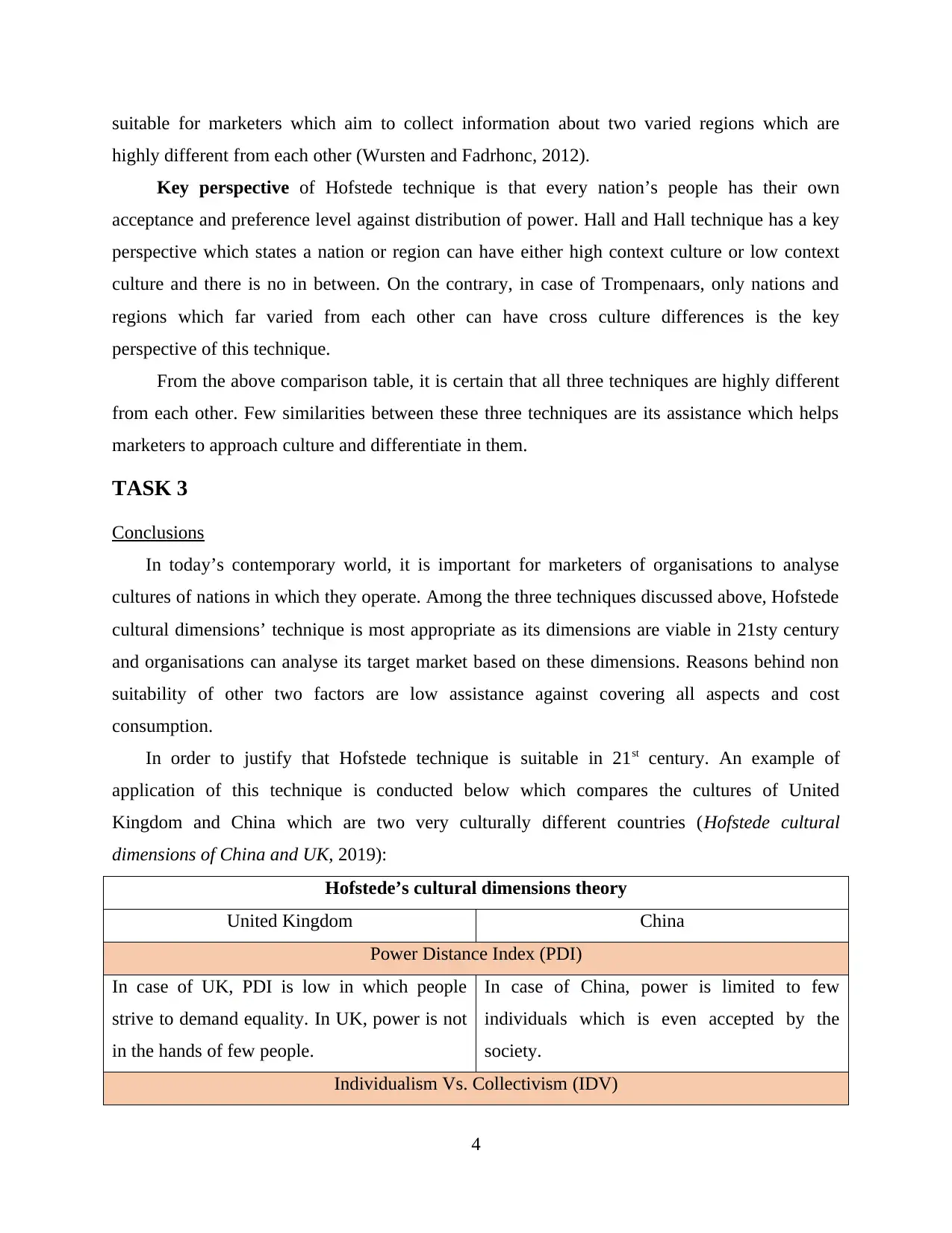
suitable for marketers which aim to collect information about two varied regions which are
highly different from each other (Wursten and Fadrhonc, 2012).
Key perspective of Hofstede technique is that every nation’s people has their own
acceptance and preference level against distribution of power. Hall and Hall technique has a key
perspective which states a nation or region can have either high context culture or low context
culture and there is no in between. On the contrary, in case of Trompenaars, only nations and
regions which far varied from each other can have cross culture differences is the key
perspective of this technique.
From the above comparison table, it is certain that all three techniques are highly different
from each other. Few similarities between these three techniques are its assistance which helps
marketers to approach culture and differentiate in them.
TASK 3
Conclusions
In today’s contemporary world, it is important for marketers of organisations to analyse
cultures of nations in which they operate. Among the three techniques discussed above, Hofstede
cultural dimensions’ technique is most appropriate as its dimensions are viable in 21sty century
and organisations can analyse its target market based on these dimensions. Reasons behind non
suitability of other two factors are low assistance against covering all aspects and cost
consumption.
In order to justify that Hofstede technique is suitable in 21st century. An example of
application of this technique is conducted below which compares the cultures of United
Kingdom and China which are two very culturally different countries (Hofstede cultural
dimensions of China and UK, 2019):
Hofstede’s cultural dimensions theory
United Kingdom China
Power Distance Index (PDI)
In case of UK, PDI is low in which people
strive to demand equality. In UK, power is not
in the hands of few people.
In case of China, power is limited to few
individuals which is even accepted by the
society.
Individualism Vs. Collectivism (IDV)
4
highly different from each other (Wursten and Fadrhonc, 2012).
Key perspective of Hofstede technique is that every nation’s people has their own
acceptance and preference level against distribution of power. Hall and Hall technique has a key
perspective which states a nation or region can have either high context culture or low context
culture and there is no in between. On the contrary, in case of Trompenaars, only nations and
regions which far varied from each other can have cross culture differences is the key
perspective of this technique.
From the above comparison table, it is certain that all three techniques are highly different
from each other. Few similarities between these three techniques are its assistance which helps
marketers to approach culture and differentiate in them.
TASK 3
Conclusions
In today’s contemporary world, it is important for marketers of organisations to analyse
cultures of nations in which they operate. Among the three techniques discussed above, Hofstede
cultural dimensions’ technique is most appropriate as its dimensions are viable in 21sty century
and organisations can analyse its target market based on these dimensions. Reasons behind non
suitability of other two factors are low assistance against covering all aspects and cost
consumption.
In order to justify that Hofstede technique is suitable in 21st century. An example of
application of this technique is conducted below which compares the cultures of United
Kingdom and China which are two very culturally different countries (Hofstede cultural
dimensions of China and UK, 2019):
Hofstede’s cultural dimensions theory
United Kingdom China
Power Distance Index (PDI)
In case of UK, PDI is low in which people
strive to demand equality. In UK, power is not
in the hands of few people.
In case of China, power is limited to few
individuals which is even accepted by the
society.
Individualism Vs. Collectivism (IDV)
4
Paraphrase This Document
Need a fresh take? Get an instant paraphrase of this document with our AI Paraphraser
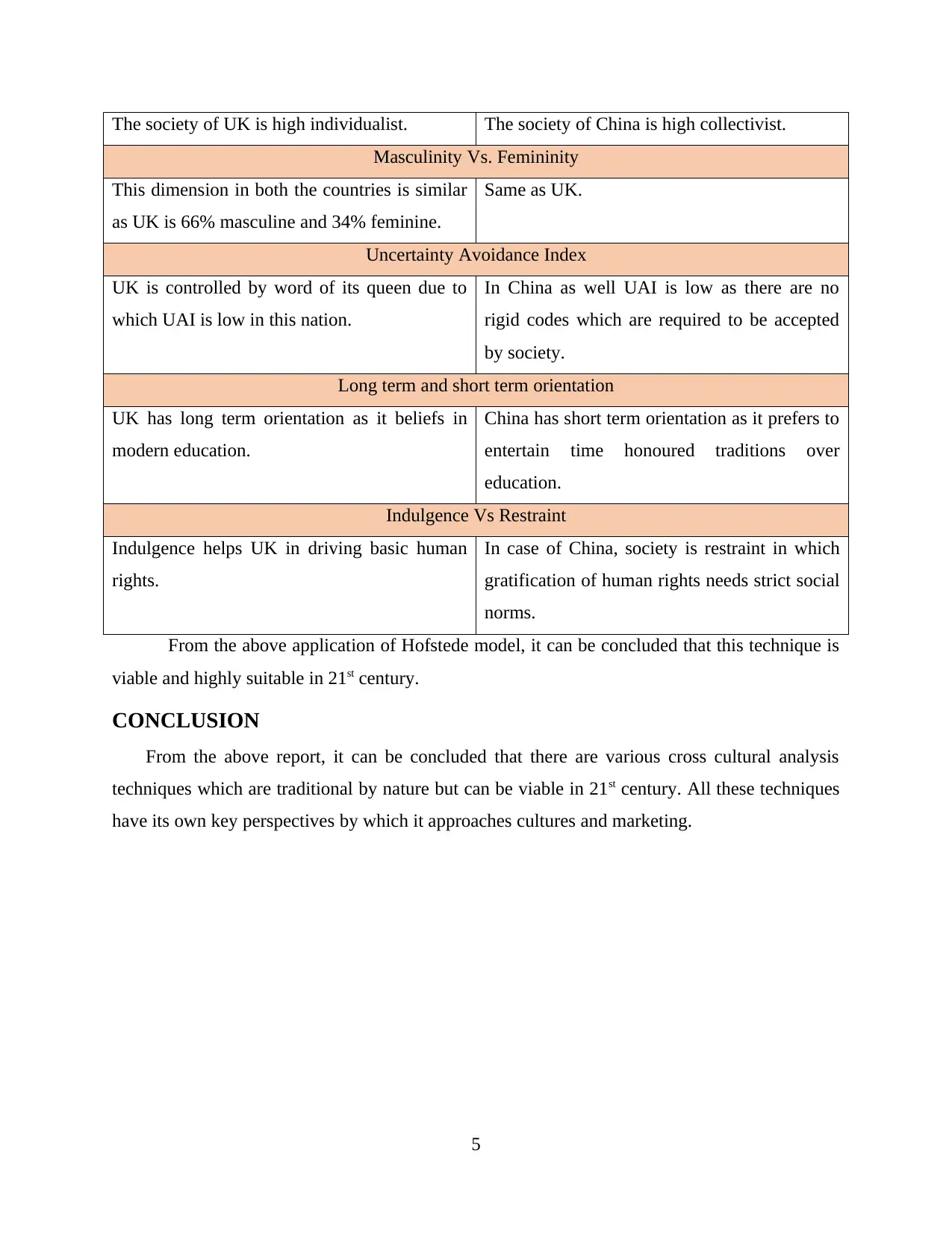
The society of UK is high individualist. The society of China is high collectivist.
Masculinity Vs. Femininity
This dimension in both the countries is similar
as UK is 66% masculine and 34% feminine.
Same as UK.
Uncertainty Avoidance Index
UK is controlled by word of its queen due to
which UAI is low in this nation.
In China as well UAI is low as there are no
rigid codes which are required to be accepted
by society.
Long term and short term orientation
UK has long term orientation as it beliefs in
modern education.
China has short term orientation as it prefers to
entertain time honoured traditions over
education.
Indulgence Vs Restraint
Indulgence helps UK in driving basic human
rights.
In case of China, society is restraint in which
gratification of human rights needs strict social
norms.
From the above application of Hofstede model, it can be concluded that this technique is
viable and highly suitable in 21st century.
CONCLUSION
From the above report, it can be concluded that there are various cross cultural analysis
techniques which are traditional by nature but can be viable in 21st century. All these techniques
have its own key perspectives by which it approaches cultures and marketing.
5
Masculinity Vs. Femininity
This dimension in both the countries is similar
as UK is 66% masculine and 34% feminine.
Same as UK.
Uncertainty Avoidance Index
UK is controlled by word of its queen due to
which UAI is low in this nation.
In China as well UAI is low as there are no
rigid codes which are required to be accepted
by society.
Long term and short term orientation
UK has long term orientation as it beliefs in
modern education.
China has short term orientation as it prefers to
entertain time honoured traditions over
education.
Indulgence Vs Restraint
Indulgence helps UK in driving basic human
rights.
In case of China, society is restraint in which
gratification of human rights needs strict social
norms.
From the above application of Hofstede model, it can be concluded that this technique is
viable and highly suitable in 21st century.
CONCLUSION
From the above report, it can be concluded that there are various cross cultural analysis
techniques which are traditional by nature but can be viable in 21st century. All these techniques
have its own key perspectives by which it approaches cultures and marketing.
5
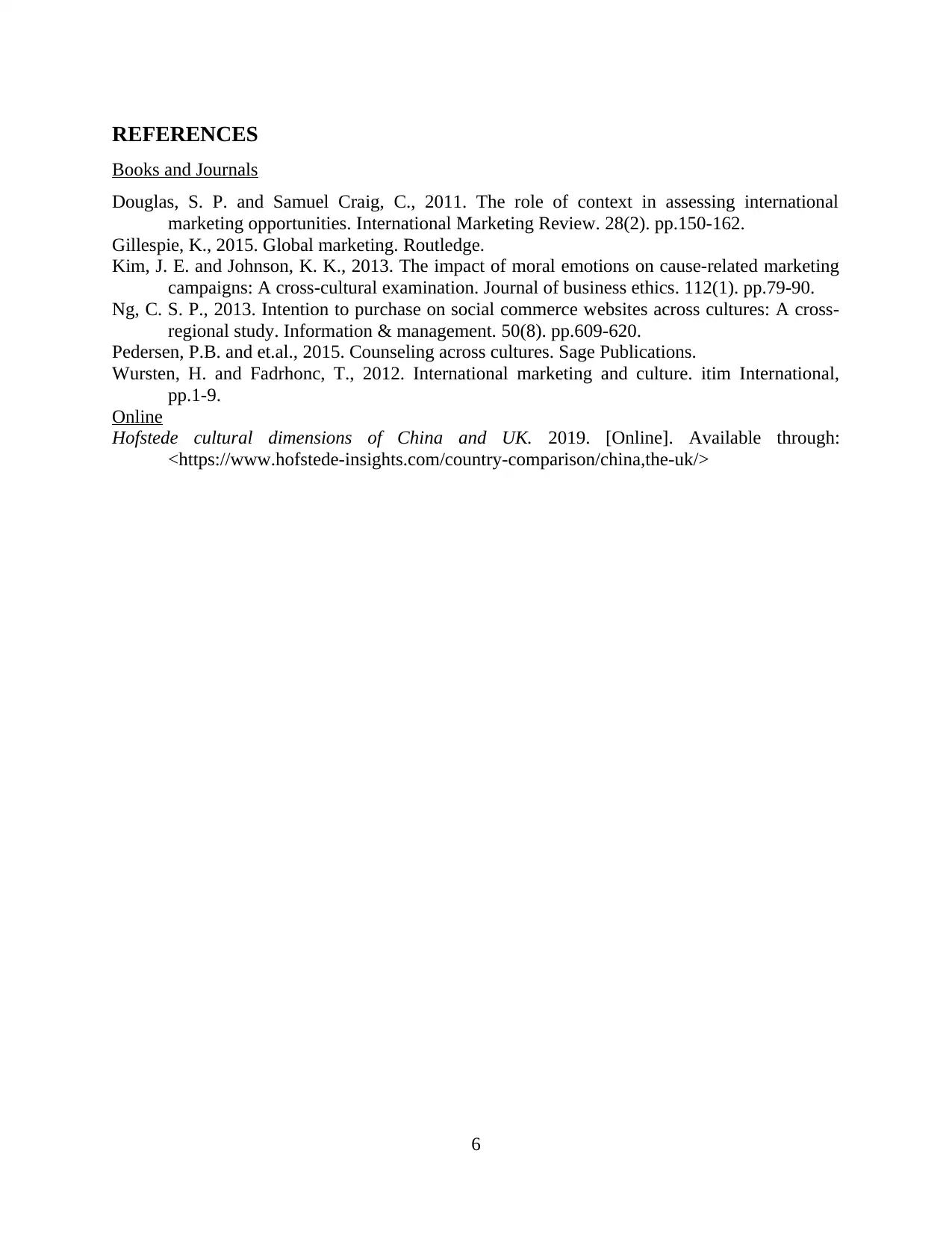
REFERENCES
Books and Journals
Douglas, S. P. and Samuel Craig, C., 2011. The role of context in assessing international
marketing opportunities. International Marketing Review. 28(2). pp.150-162.
Gillespie, K., 2015. Global marketing. Routledge.
Kim, J. E. and Johnson, K. K., 2013. The impact of moral emotions on cause-related marketing
campaigns: A cross-cultural examination. Journal of business ethics. 112(1). pp.79-90.
Ng, C. S. P., 2013. Intention to purchase on social commerce websites across cultures: A cross-
regional study. Information & management. 50(8). pp.609-620.
Pedersen, P.B. and et.al., 2015. Counseling across cultures. Sage Publications.
Wursten, H. and Fadrhonc, T., 2012. International marketing and culture. itim International,
pp.1-9.
Online
Hofstede cultural dimensions of China and UK. 2019. [Online]. Available through:
<https://www.hofstede-insights.com/country-comparison/china,the-uk/>
6
Books and Journals
Douglas, S. P. and Samuel Craig, C., 2011. The role of context in assessing international
marketing opportunities. International Marketing Review. 28(2). pp.150-162.
Gillespie, K., 2015. Global marketing. Routledge.
Kim, J. E. and Johnson, K. K., 2013. The impact of moral emotions on cause-related marketing
campaigns: A cross-cultural examination. Journal of business ethics. 112(1). pp.79-90.
Ng, C. S. P., 2013. Intention to purchase on social commerce websites across cultures: A cross-
regional study. Information & management. 50(8). pp.609-620.
Pedersen, P.B. and et.al., 2015. Counseling across cultures. Sage Publications.
Wursten, H. and Fadrhonc, T., 2012. International marketing and culture. itim International,
pp.1-9.
Online
Hofstede cultural dimensions of China and UK. 2019. [Online]. Available through:
<https://www.hofstede-insights.com/country-comparison/china,the-uk/>
6
⊘ This is a preview!⊘
Do you want full access?
Subscribe today to unlock all pages.

Trusted by 1+ million students worldwide
1 out of 9
Related Documents
Your All-in-One AI-Powered Toolkit for Academic Success.
+13062052269
info@desklib.com
Available 24*7 on WhatsApp / Email
![[object Object]](/_next/static/media/star-bottom.7253800d.svg)
Unlock your academic potential
Copyright © 2020–2025 A2Z Services. All Rights Reserved. Developed and managed by ZUCOL.





